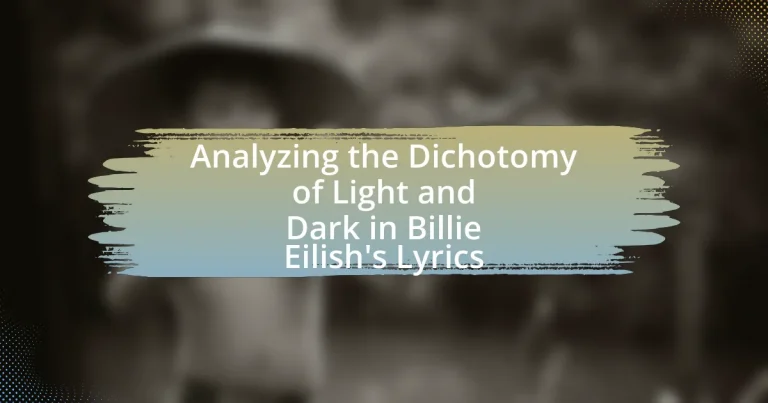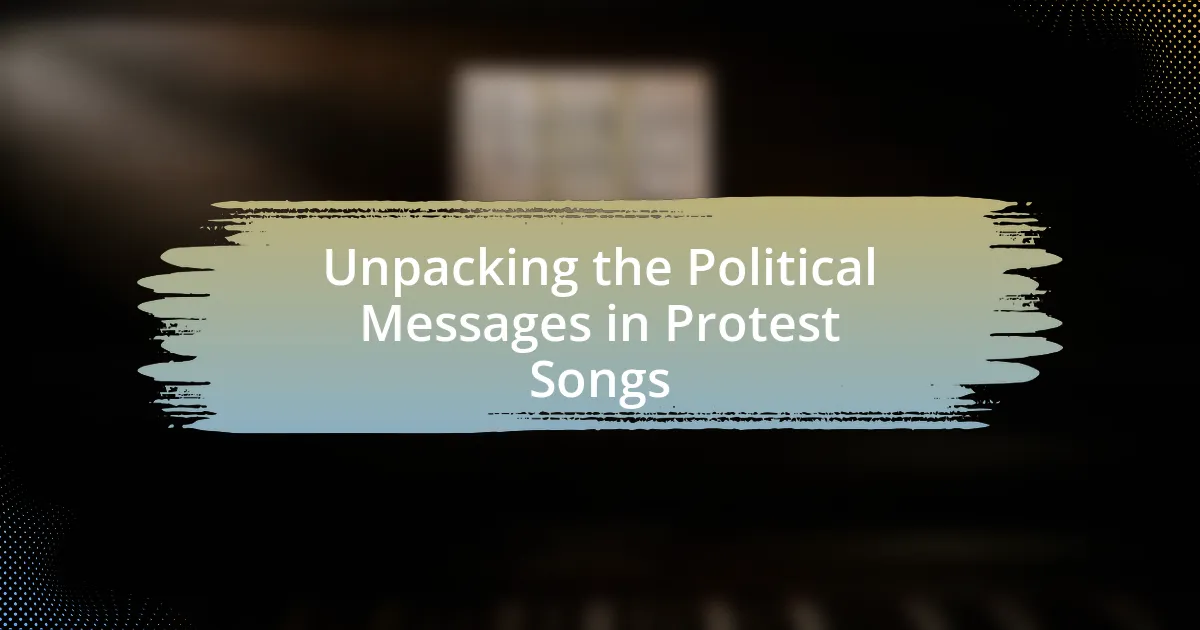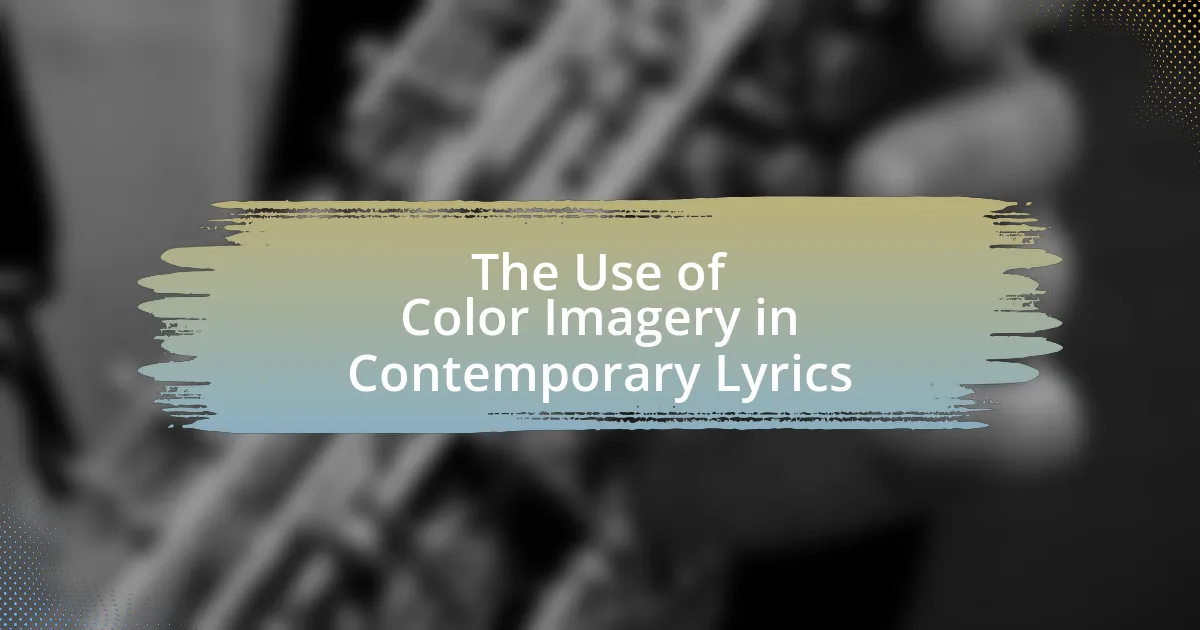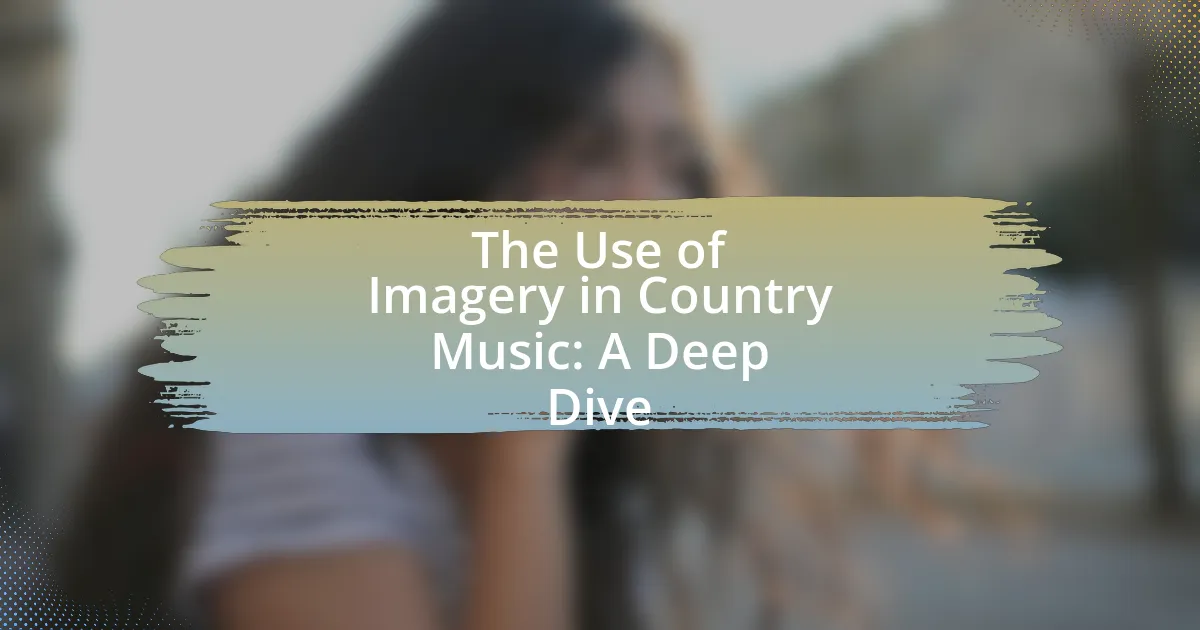The article analyzes the dichotomy of light and dark in Billie Eilish’s lyrics, highlighting the contrast between innocence and experience, joy and sorrow, and hope and despair. It examines how Eilish employs light and dark imagery to convey emotional complexity, using specific songs like “Bellyache,” “When the Party’s Over,” and “Bad Guy” as examples. The discussion includes the evolution of this theme throughout her discography, the impact on her artistic identity, and the insights gained about mental health and emotional expression. Overall, the article underscores the significance of these contrasting elements in Eilish’s work and their resonance with her audience.
What is the Dichotomy of Light and Dark in Billie Eilish’s Lyrics?
The dichotomy of light and dark in Billie Eilish’s lyrics represents the contrast between innocence and experience, joy and sorrow, and hope and despair. Eilish frequently explores themes of mental health, vulnerability, and existential angst, often juxtaposing bright imagery with darker emotions. For instance, in songs like “Bellyache,” she reflects on guilt and remorse, while “Goodbye” conveys a sense of loss and longing. This interplay highlights the complexity of human emotions, illustrating how light and dark coexist within personal narratives. Eilish’s ability to blend these contrasting elements resonates with listeners, making her work relatable and impactful.
How does Billie Eilish use light and dark imagery in her songs?
Billie Eilish employs light and dark imagery in her songs to convey emotional complexity and contrast. For instance, in tracks like “Bellyache,” she juxtaposes themes of guilt and innocence, using bright sounds alongside darker lyrical content to create a sense of tension. This duality is evident in her use of vivid descriptions that evoke both uplifting and haunting visuals, allowing listeners to experience a spectrum of emotions. Eilish’s ability to blend these contrasting elements enhances the depth of her storytelling, making her music resonate on multiple levels.
What specific lyrics exemplify the contrast between light and dark?
Specific lyrics that exemplify the contrast between light and dark in Billie Eilish’s work include lines from “Bellyache,” where she juxtaposes feelings of guilt and innocence. In this song, Eilish expresses a sense of remorse for her actions, highlighting the darkness of her conscience against the lightness of youthful freedom. The lyrics “Where’s my mind? / Maybe it’s in the gutter” illustrate this dichotomy, as they reflect a struggle between carefree living and the weight of moral conflict. This contrast is a recurring theme in her music, effectively showcasing the interplay between light and dark emotions.
How do these images reflect her emotional state?
The images reflect her emotional state by visually representing the contrast between vulnerability and strength. For instance, darker imagery may symbolize feelings of sadness or anxiety, while lighter elements can indicate moments of hope or resilience. This duality mirrors the themes present in Billie Eilish’s lyrics, where she often explores complex emotions, such as despair juxtaposed with empowerment. The use of color and composition in the images serves to enhance this emotional narrative, providing a visual context that aligns with the lyrical exploration of light and dark.
Why is the theme of light and dark significant in her music?
The theme of light and dark is significant in Billie Eilish’s music as it reflects the complexities of human emotions and experiences. Eilish often juxtaposes these elements to convey feelings of hope and despair, illustrating the duality of life. For instance, her song “When the Party’s Over” uses the contrast of light and dark to explore themes of heartbreak and vulnerability, emphasizing how joy can coexist with pain. This thematic dichotomy resonates with listeners, allowing them to connect deeply with her lyrics and understand the multifaceted nature of their own emotions.
What cultural or personal influences shape this dichotomy?
Cultural and personal influences that shape the dichotomy of light and dark in Billie Eilish’s lyrics include her upbringing in a creative family and the impact of contemporary societal issues. Eilish was raised in Los Angeles, where exposure to diverse artistic expressions and the entertainment industry fostered her unique style. Additionally, her lyrics often reflect personal experiences with mental health, fame, and societal pressures, which resonate with listeners facing similar struggles. For instance, her song “Bellyache” explores themes of guilt and morality, illustrating the tension between light and dark emotions. This interplay is further influenced by broader cultural narratives surrounding mental health awareness and the complexities of youth identity in modern society.
How does this theme resonate with her audience?
The theme of light and dark in Billie Eilish’s lyrics resonates deeply with her audience by reflecting their internal struggles and emotional complexities. Eilish’s exploration of contrasting emotions allows listeners to connect with their own experiences of vulnerability and resilience, as evidenced by her candid discussions of mental health and personal challenges in songs like “Bellyache” and “When the Party’s Over.” This relatability is supported by research indicating that music addressing emotional dichotomies can foster a sense of community and understanding among listeners, enhancing their emotional well-being.
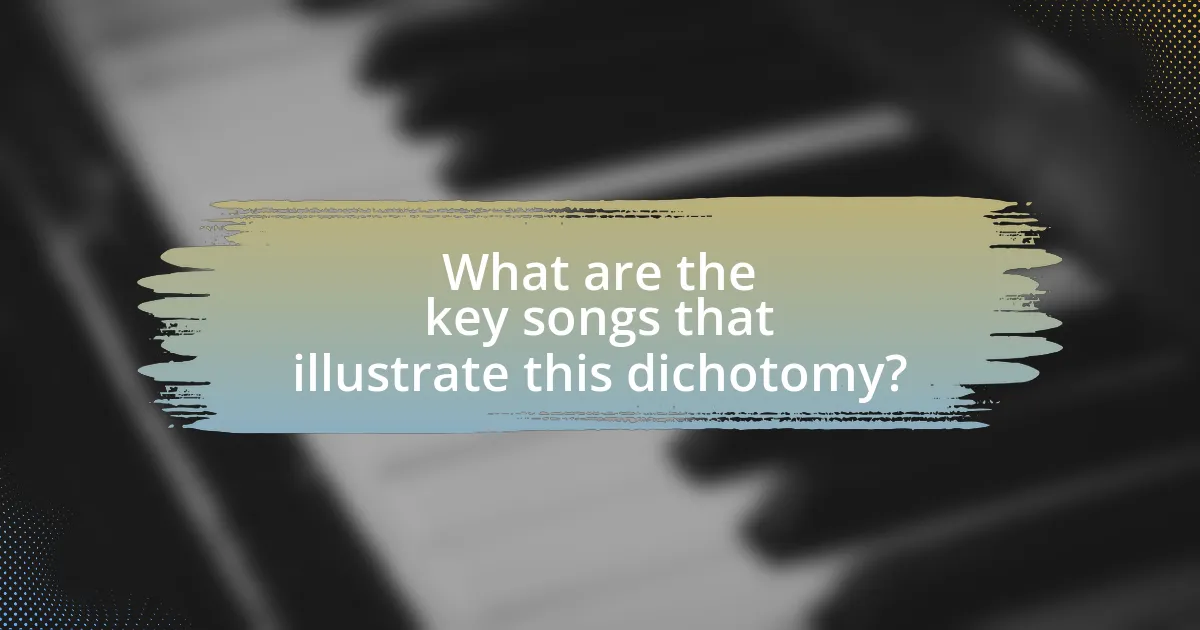
What are the key songs that illustrate this dichotomy?
Key songs that illustrate the dichotomy of light and dark in Billie Eilish’s lyrics include “Bellyache,” “When the Party’s Over,” and “Bad Guy.” “Bellyache” explores themes of guilt and innocence, contrasting a light-hearted melody with dark subject matter about remorse. “When the Party’s Over” presents a stark emotional landscape, juxtaposing vulnerability with a hauntingly beautiful arrangement, highlighting the tension between hope and despair. “Bad Guy” embodies a playful yet sinister persona, merging upbeat production with darker lyrical themes of power and manipulation. These songs collectively showcase Eilish’s ability to blend contrasting elements, effectively illustrating the light and dark dichotomy in her work.
Which songs prominently feature light and dark themes?
Songs that prominently feature light and dark themes include “Bellyache,” “When the Party’s Over,” and “Bad Guy” by Billie Eilish. In “Bellyache,” Eilish explores guilt and innocence, contrasting the carefree nature of youth with the weight of wrongdoing. “When the Party’s Over” delves into themes of heartbreak and emotional turmoil, juxtaposing vulnerability with the facade of strength. “Bad Guy” presents a playful yet sinister take on power dynamics, blending light-heartedness with darker undertones of manipulation. These songs exemplify Eilish’s ability to intertwine contrasting themes, creating a rich tapestry of emotional complexity in her lyrics.
What lyrical techniques does she employ in these songs?
Billie Eilish employs various lyrical techniques in her songs, including vivid imagery, contrasting themes, and emotional vulnerability. Vivid imagery allows listeners to visualize her experiences and emotions, as seen in lines that evoke strong sensory details. The use of contrasting themes highlights the dichotomy of light and dark, often juxtaposing happiness with sadness or innocence with despair, which deepens the emotional impact of her lyrics. Additionally, her emotional vulnerability resonates with audiences, as she candidly expresses personal struggles and fears, creating a relatable connection. These techniques collectively enhance the depth and complexity of her songwriting, making her work impactful and resonant.
How do the musical elements enhance the light and dark imagery?
Musical elements such as dynamics, instrumentation, and tempo enhance the light and dark imagery in Billie Eilish’s lyrics by creating contrasting emotional landscapes. For instance, the use of soft, ethereal sounds can evoke feelings of lightness and hope, while heavier, bass-driven elements can convey darkness and tension. This contrast is evident in songs like “When the Party’s Over,” where the minimalist piano underscores the haunting lyrics, emphasizing themes of loss and vulnerability. Additionally, variations in tempo can shift the listener’s perception, with slower tempos often associated with introspection and melancholy, reinforcing the darker imagery present in the lyrics. These musical choices effectively amplify the emotional weight of the lyrics, allowing listeners to experience the dichotomy of light and dark more profoundly.
How do critics interpret the light and dark dichotomy in her work?
Critics interpret the light and dark dichotomy in Billie Eilish’s work as a reflection of the complexities of human emotion and experience. They argue that her lyrics juxtapose themes of innocence and vulnerability with darker elements of despair and anxiety, illustrating the duality of life. For instance, in songs like “Bellyache,” Eilish explores guilt and remorse against a backdrop of youthful recklessness, showcasing how light and dark coexist within personal narratives. This interpretation is supported by her use of contrasting imagery and tonal shifts, which critics highlight as a signature aspect of her songwriting style.
What are some common interpretations among music critics?
Common interpretations among music critics regarding Billie Eilish’s lyrics often focus on the juxtaposition of light and dark themes. Critics frequently highlight how Eilish explores complex emotions, such as vulnerability and empowerment, through contrasting imagery. For instance, her song “Bellyache” is interpreted as a reflection on guilt and innocence, showcasing the tension between youthful recklessness and moral responsibility. Additionally, her use of haunting melodies paired with introspective lyrics is seen as a representation of mental health struggles, further emphasizing the light and dark dichotomy in her work. This analysis is supported by various reviews and articles that consistently note her ability to blend pop sensibilities with deeper, often darker subject matter, making her music resonate with a wide audience.
How do these interpretations align or differ from fan perceptions?
Interpretations of the dichotomy of light and dark in Billie Eilish’s lyrics often align with fan perceptions, as many fans resonate with the themes of vulnerability and emotional complexity present in her work. For instance, fans frequently cite songs like “Bellyache” and “When the Party’s Over” as reflections of internal struggles, mirroring critical analyses that highlight Eilish’s exploration of contrasting emotions. However, some interpretations may differ, particularly regarding the extent to which fans perceive these themes as autobiographical versus artistic expression. While fans may view her lyrics as deeply personal, some critics argue that Eilish employs these themes more as a narrative device than as direct reflections of her life experiences. This divergence illustrates the multifaceted nature of her artistry and the varied ways fans engage with her music.
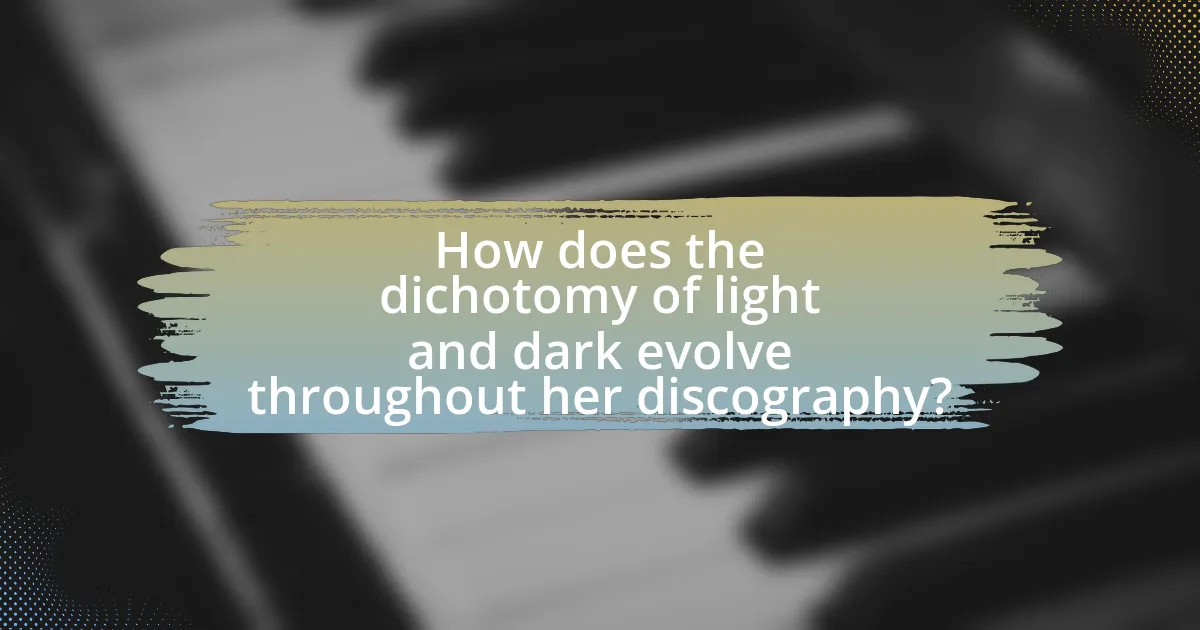
How does the dichotomy of light and dark evolve throughout her discography?
The dichotomy of light and dark in Billie Eilish’s discography evolves from a stark contrast in her early work to a more nuanced exploration in her later albums. In her debut EP, “Don’t Smile at Me,” Eilish presents clear themes of vulnerability and darkness, as seen in tracks like “Bellyache,” where guilt and remorse are juxtaposed with youthful innocence. As her discography progresses into her album “When We All Fall Asleep, Where Do We Go?”, the interplay between light and dark becomes more complex, reflecting a deeper understanding of mental health and societal issues, particularly in songs like “Bad Guy” and “Bury a Friend,” which blend playful elements with darker undertones. By the time of her album “Happier Than Ever,” Eilish integrates light and dark more seamlessly, showcasing personal growth and acceptance, as evident in tracks like “Your Power,” where she addresses themes of empowerment amidst vulnerability. This evolution illustrates her journey from a simplistic dichotomy to a sophisticated interplay of contrasting emotions, reflecting her artistic maturation and the complexities of human experience.
What changes can be observed in her approach to this theme over time?
Billie Eilish’s approach to the theme of light and dark in her lyrics has evolved from a more simplistic dichotomy to a nuanced exploration of emotional complexity. Initially, her early work, such as in the song “Bellyache,” presents a clear contrast between guilt and innocence, reflecting a straightforward interpretation of light versus dark. Over time, as seen in tracks like “When the Party’s Over,” her lyrics delve deeper into the interplay of these themes, illustrating a blend of vulnerability and strength, where light and dark coexist rather than oppose each other. This shift indicates a maturation in her songwriting, showcasing a more sophisticated understanding of human emotions and experiences.
How do her earlier works compare to her more recent releases?
Billie Eilish’s earlier works, such as her debut EP “Don’t Smile at Me,” exhibit a raw, introspective style characterized by themes of vulnerability and emotional turmoil. In contrast, her more recent releases, including the album “Happier Than Ever,” showcase a more polished production and a broader exploration of complex emotions, reflecting personal growth and a nuanced understanding of her experiences. This evolution is evident in the lyrical depth and musical sophistication, with recent tracks incorporating a wider range of influences and a more mature perspective on relationships and self-identity.
What factors contribute to the evolution of this theme in her lyrics?
The evolution of the theme of light and dark in Billie Eilish’s lyrics is influenced by her personal experiences, societal issues, and artistic collaborations. Eilish’s lyrics often reflect her struggles with mental health, which adds depth to the dichotomy, as seen in songs like “Bellyache” and “When the Party’s Over,” where she juxtaposes feelings of guilt and sorrow with moments of clarity. Additionally, societal themes such as fame and its impact on identity contribute to this evolution, as Eilish navigates the complexities of public perception and personal authenticity. Collaborations with producers like Finneas O’Connell further enhance this theme, as they create soundscapes that complement the lyrical contrasts, reinforcing the interplay between light and dark in her music.
What impact does this dichotomy have on her overall artistic identity?
The dichotomy of light and dark in Billie Eilish’s lyrics significantly shapes her overall artistic identity by creating a complex emotional landscape that resonates with her audience. This duality allows her to explore themes of vulnerability and strength, reflecting the multifaceted nature of human experience. For instance, songs like “Bellyache” juxtapose feelings of guilt and innocence, illustrating her ability to convey deep emotional conflicts. This contrast not only enhances her lyrical depth but also establishes her as an artist who embraces ambiguity, making her work relatable and impactful.
How does it shape her public persona and brand?
Billie Eilish’s exploration of light and dark themes in her lyrics significantly shapes her public persona and brand by establishing her as an authentic and relatable artist. This duality resonates with a wide audience, particularly younger listeners who often grapple with complex emotions. Eilish’s candidness about mental health struggles and societal pressures, as reflected in songs like “Bellyache” and “When the Party’s Over,” reinforces her image as a voice for the misunderstood. The contrast in her music not only highlights her artistic versatility but also cultivates a brand that embraces vulnerability, making her a symbol of authenticity in the music industry.
In what ways does it influence her collaborations and performances?
Billie Eilish’s exploration of the dichotomy of light and dark in her lyrics significantly influences her collaborations and performances by fostering a unique emotional depth and authenticity. This thematic duality allows her to connect with diverse artists who resonate with similar complexities, leading to collaborations that blend various genres and styles, such as her work with Finneas O’Connell, which often reflects both vulnerability and strength. Additionally, her performances are characterized by visual and auditory contrasts that enhance the emotional impact of her music, as seen in her use of lighting and stage design that mirror the themes in her songs, creating an immersive experience for the audience. This approach not only captivates listeners but also establishes her as a distinctive voice in contemporary music, reinforcing her artistic identity.
What can listeners learn from the light and dark themes in her lyrics?
Listeners can learn about the complexities of human emotions and experiences through the light and dark themes in Billie Eilish’s lyrics. These themes illustrate the coexistence of joy and sorrow, highlighting how contrasting feelings shape personal narratives. For example, Eilish often juxtaposes uplifting melodies with introspective or melancholic lyrics, which reflects the duality of life. This approach encourages listeners to embrace their own emotional spectrum, recognizing that light and dark moments are integral to the human experience.
How can these themes be applied to personal experiences?
The themes of light and dark in Billie Eilish’s lyrics can be applied to personal experiences by reflecting the complexities of human emotions and situations. For instance, individuals often navigate feelings of joy and despair, similar to the contrasts Eilish portrays in her music. This duality can help people understand their own emotional struggles, as research indicates that recognizing and articulating such feelings can lead to better mental health outcomes (American Psychological Association, 2020). By relating personal experiences to these themes, individuals can foster self-awareness and resilience, ultimately aiding in their emotional growth.
What insights can be gained about mental health and emotional expression?
Insights into mental health and emotional expression reveal that individuals often use creative outlets, such as music, to articulate complex feelings and experiences. Billie Eilish’s lyrics exemplify this, as they navigate themes of anxiety, depression, and vulnerability, reflecting the struggles many face. Research indicates that expressive writing and artistic expression can significantly improve mental well-being by providing a means to process emotions and experiences (Pennebaker, 1997). This connection between emotional expression and mental health underscores the importance of art as a therapeutic tool, allowing individuals to confront and communicate their inner turmoil effectively.
